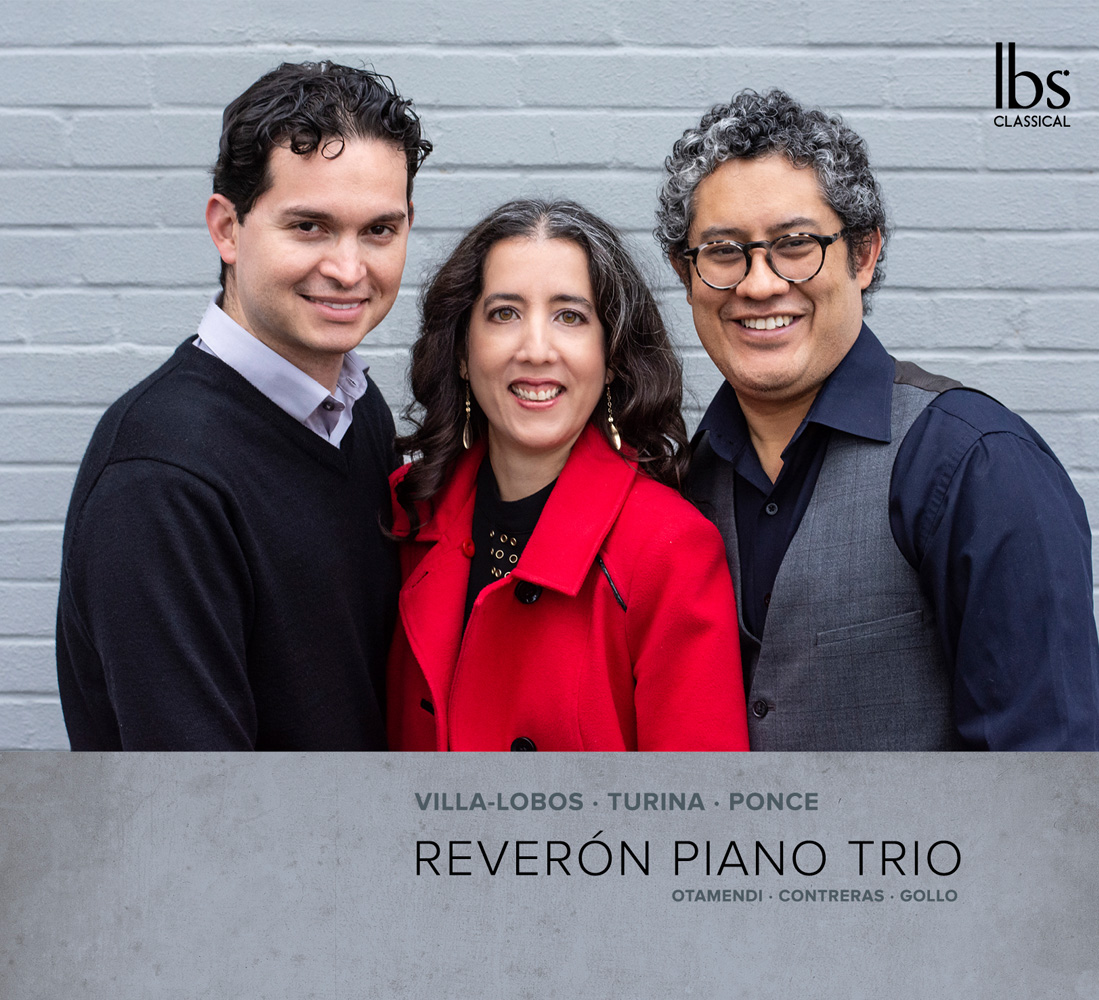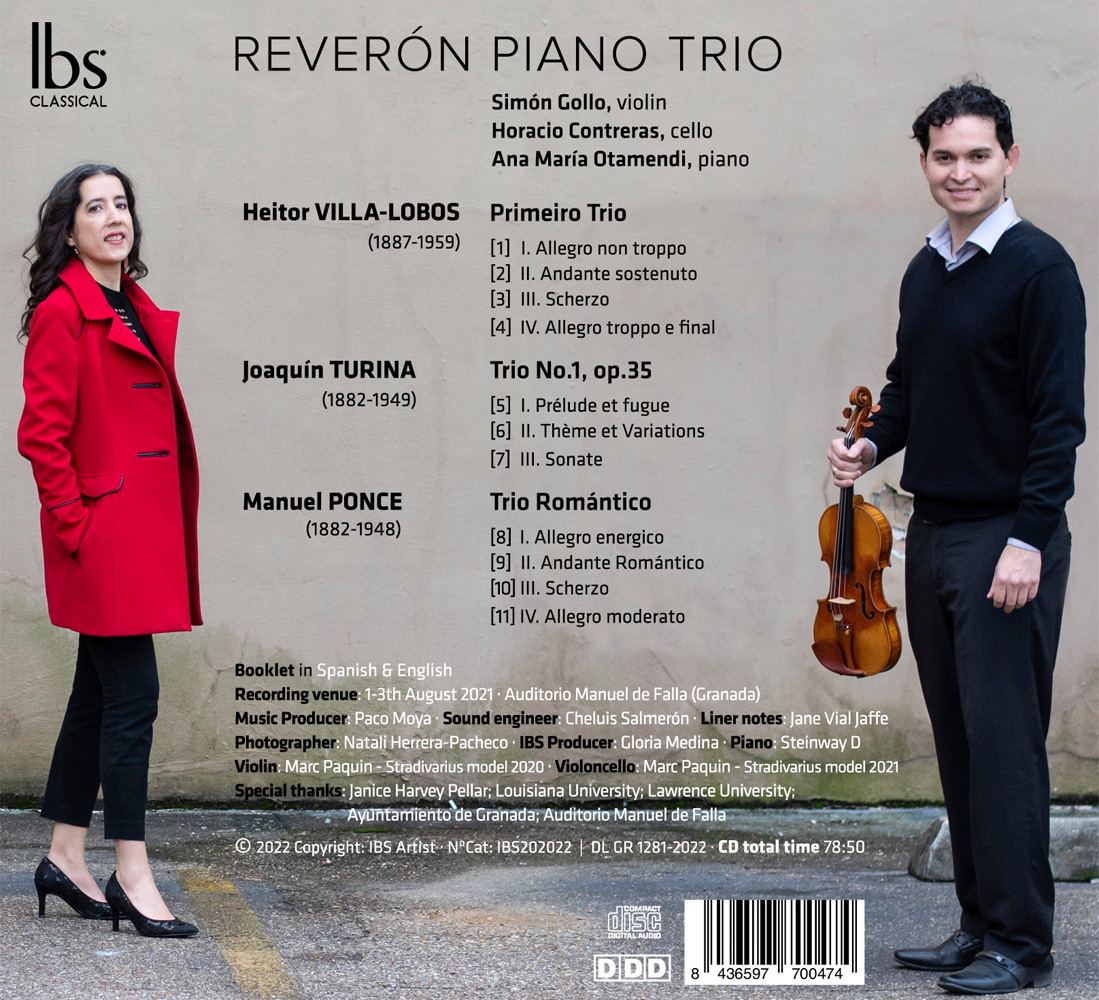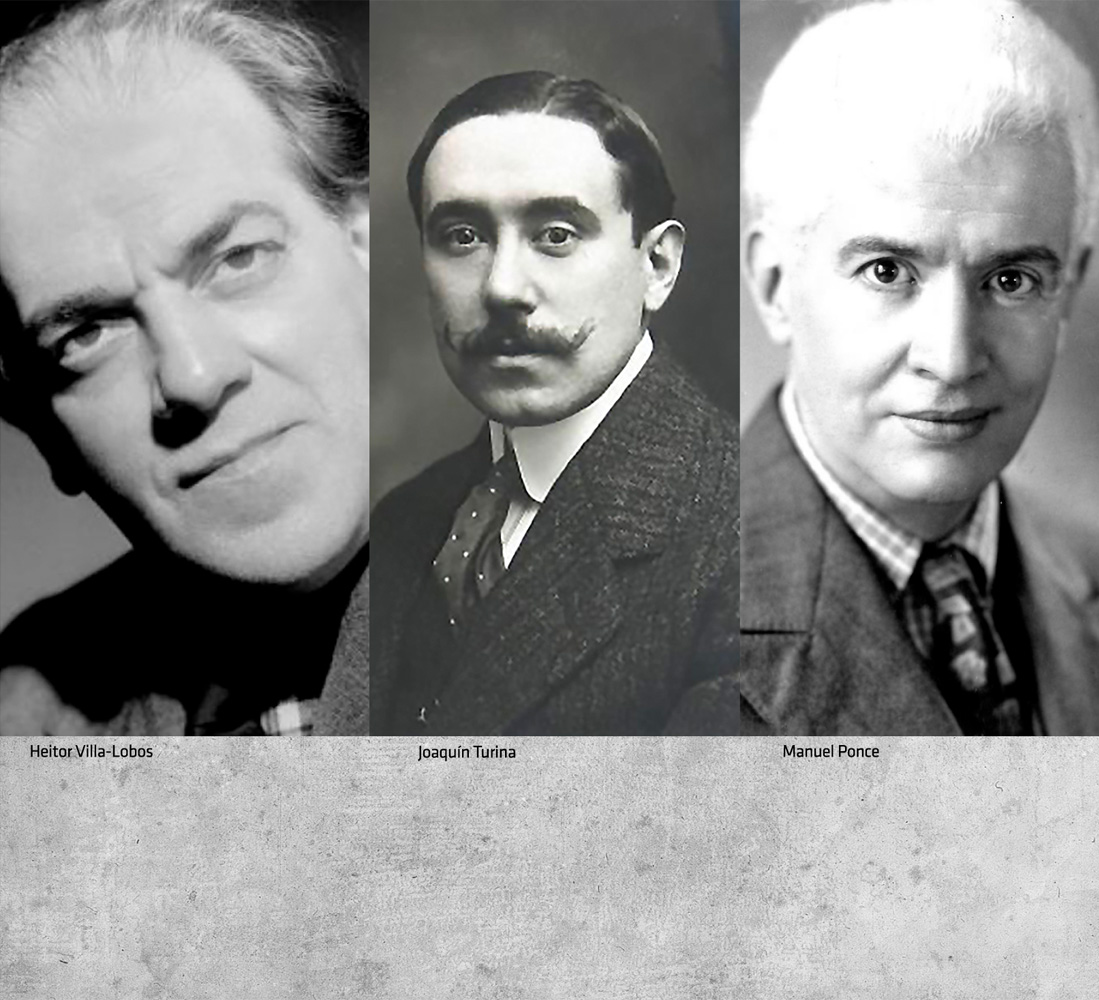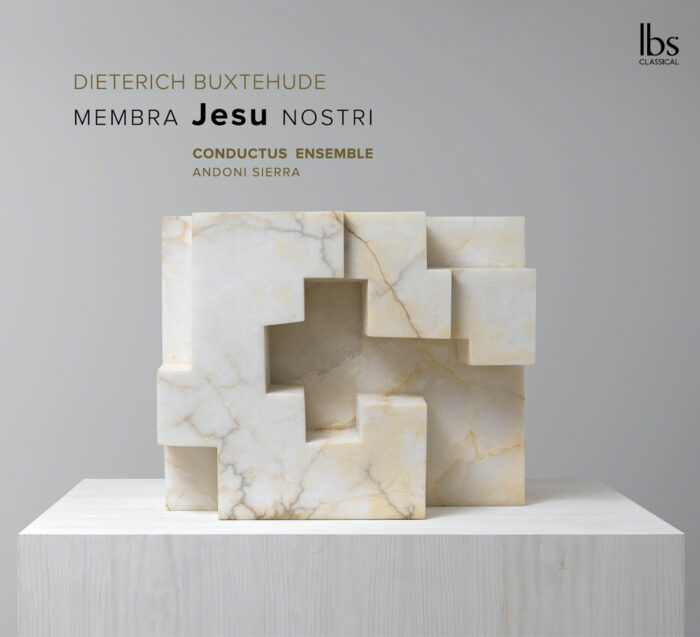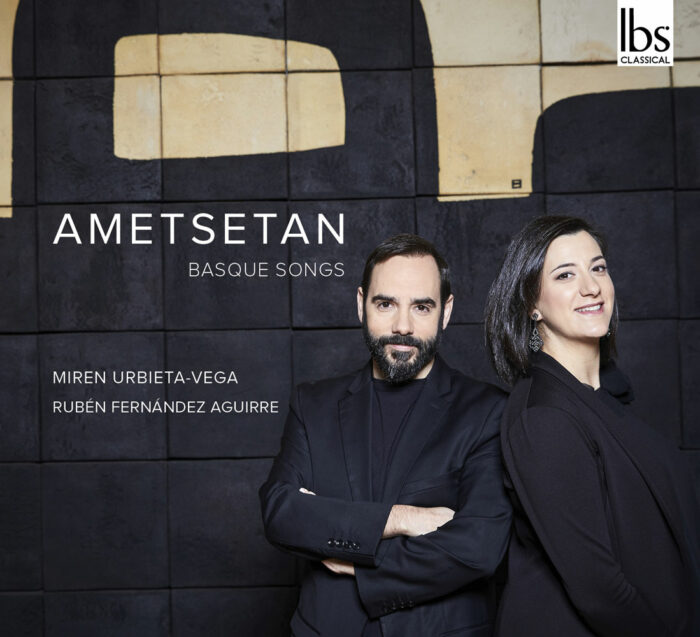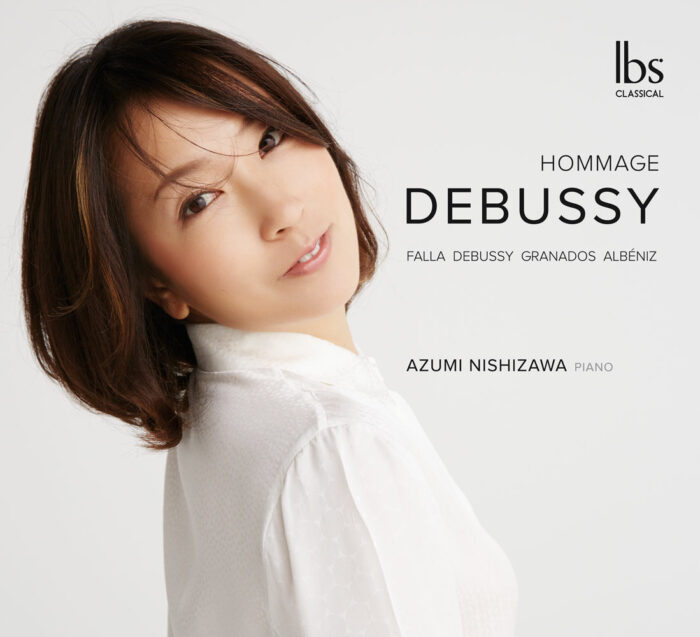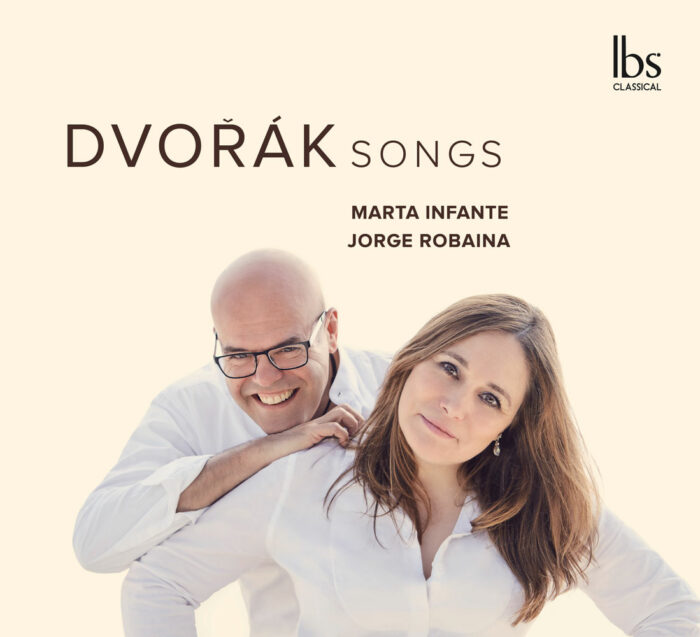Trios Hispanos
M. Ponce: Trio Romántico, III.Scherzo (select.)
14,95€
The Reverón Piano Trio’s main goal is to introduce audiences to underrepresented music from Latin America alongside contemporary and standard repertoire. These artists are active promoters of Latin American music through their work as performing artists, scholars and entrepreneurs, and they have devoted their careers to the discovery, cataloging, performance, editing, and recording of this rich repertoire. In addition, the trio continues to commission new works, and is in the process of creating the Sphinx Catalog of Latin American Piano Trios. The three composers of this album, Villa-Lobos, Turina and Ponce were born within 5 years of each other. Manuel Ponce’s Trio Romántico, Joaquín Turina’s Piano Trio No. 1, and Heitor Villa-Lobos’s Piano Trio No. 1 were composed within fifteen years of one another in the first quarter of the twentieth century, and representing Mexico, Spain, and Brazil but also outside influences.
14,95€
Reveron Piano Trio
The Reverón Piano Trio’s main goal is to introduce audiences to underrepresented music from Latin America alongside contemporary and standard repertoire. These artists are active promoters of Latin American music through their work as performing artists, scholars and entrepreneurs, and they have devoted their careers to the discovery, cataloging, performance, editing, and recording of this rich repertoire. In addition, the trio continues to commission new works, and is in the process of creating the Sphinx Catalog of Latin American Piano Trios.
The Reverón Trio is named after Venezuelan painter and sculptor Armando Reverón (1889-1954), one of the earliest American modernists and considered one of the most important visual artists in Latin America. Even though Reverón is now regarded as a highly influential figure in Latin America, his work is not celebrated outside the borders of Venezuela. It is the trio’s wish to enhance multicultural understanding and increase the visibility of Reverón’s work and of Latin American music. Ana María, Simón, and Horacio are all Venezuelan artists that have made their home in the United States.
Recent engagements include concerts at the Festival Casals in Puerto Rico, Aruba Symphony Festival, Beethoven Festival Park City, Festival A la Vela de la Alhambra in Granada, and Universidad de los Andes in Bogotá, Colombia. Additionally, the trio has been in residence at the University of Michigan, Michigan State University, University of Wisconsin, Dickinson College, Lawrence University, Louisiana State University, the Westfield Center for Historical Keyboard Studies, the Collaborative Piano Institute, and various other universities in the U.S. and abroad.
The trio is managed in the United States by Meluk Kulturmanagement and in Latin America and Europe in society by Halac Artists – Meluk Kulturmanagement.
Ponce: Trio Romántico
Ponce began composing his Piano Trio during his first trip to Europe, 1904–06, when he also wrote a number of other small chamber works all in the Romantic style. He performed some of the Trio in March 1911 and January 1912 and eventually completed the work on May 11, 1912. He premiered the complete Trio with violinist Pedro Valdez Fraga and cellist Ruben Montiel on July 9 that year in Mexico City at the ambitious concert of his own works mentioned above. Though the Trio does not use Mexican folk elements, it made an equally important impact (along with his Piano Concerto) for its addition of large-scale forms to the Mexican concert scene.
First published in Havana in 1912 simply as Trio for Violin Cello, and Piano, the work became known as the Trio Romántico on account of its slow movement, which Ponce designated “Andante romántico.” The nickname admirably suits the full-blown Romanticism of the entire Trio. The surging energy of the first movement’s opening with its syncopated piano chords and decisive three-note-motive make this immediately apparent as does the rich melodic material of the main theme proper with stepwise flow contrasted by expressive leaps. Ponce immediately varies the main theme and continues to transform it throughout the movement, which lends a variation-like quality to his sonata form. Perhaps the most striking feature of the movement is the dramatic closing theme of the exposition with its pounding triplet repeated chords. The thrill remains when the theme returns to close Ponce’s freely treated recapitulation.
The Andante romántico, written 5 or 6 years after the first movement, exhibits the intimacy of the Mexican salon music of Ponce’s early style, influenced by such late nineteenth-century composers as Ernesto Elorduy, Felipe Villanueva, and Ricardo Castro. With its flowing triple meter, the piece sounds like a mazurka (Polish dance form), and, in fact, scholars have noticed a similarity between its opening and that of Ponce’s own Mazurka No. 23.
The Scherzo dances along merrily as a playful conversation between the piano and the strings. The beautiful melody of the middle section provides supreme contrast, after which the Scherzo returns exactly as before.
The last movement bristles with restless energy—that is, until the lyrical second theme creates a complete change of mood. The cello receives a special melodic spotlight in this section as does the piano, with pizzicato interjections from the strings. Ponce shows his “academic” side by beginning the development with a fugue-like section that builds to a huge climax before the restlessness of the recapitulation begins. Unexpectedly, Ponce closes the movement in ethereal serenity. Jane Vial Jaffe
Turina: Piano Trio N.1
Composed between May 19, 1925, and February 1926, the Piano Trio No. 1 Op. 35 in D major was not actually Turina’s first work in the genre. He had written a little-known but substantial Piano Trio in F major in 1904, before he had developed his more personal Spanish-infused style, which was surely why he considered the Op. 35 his “first.” He submitted the D major Trio, along with several other compositions, to the National Music Competition of Spain, and in May 1926 he received a “diploma” and cash prize of 3,000 pesetas. The work was published the same year in Paris, dedicated to the Infanta Isabel de Borbón of Spain. The premiere took place at a concert of the Anglo-Spanish Music Society in London on July 5, 1927, with the composer at the piano and violinist Enid Balby and cellist Lily Phillips.
The D major Trio unfolds in three movements, of which the first, Prelude and Fugue, begins strikingly with slow, searing lines in the violin and cello that start to converge but ultimately descend. The piano takes over, introducing the languorous dotted (long-short) rhythms, solemn chordal treading, and Impressionistic triplet motion that provide material for the remainder of the Prelude. A return of the violin/cello opening leads to the cheerful Fugue that Turina labels “inverse”—not referring to inversion of the subject but to the fact that the fugue begins in stretto (imitations of the fugue subject in quick succession before each is completed), which is something that typically happens later in the form. The salient feature here, however, is that his contrapuntal technique is cleverly hidden amid lush textures, and that the subject and answer of the fugue end the movement.
Turina’s choice of a theme and variations for his middle movement follows a long tradition of variations in Spanish music that dates back to the sixteenth century. The cello introduces the expressive theme, joined by the violin, over gentle piano chords. As he often did, Turina draws on Spanish dance types for his five ensuing variations. The first, a muiñeira (miller’s dance) from Galicia, lilts along in the traditional 6/8 meter, and the second, a schotis originally from Northern Europe but popular in Spain, shows a bit of Turina’s insouciant character. The third, for piano alone, represents the Basque zortziko in the typical 5/8 meter but also contains a hint of jazz. In the fourth, a jota from Aragon, passages of lyrical melody accompanied by lively pizzicato in triple meter alternate with slower chordal music in duple meter. The fifth variation, a soleares that represents Turina’s native Andalusia, peaks expressively before the original theme returns.
Turina labels the final movement “Sonata,” though it is a very free interpretation of the form. It opens in a burst of energy and joy, contrasted by a more relaxed second theme, but the most striking feature is his return to the materials of the first movement, both the prelude and the fugue, which unifies the entire work. Jane Vial Jaffe
Villa-Lobos Piano Trio
Though not published until 1956, Villa-Lobos’s Piano Trio No. 1 is actually an early work. Composed in 1911, the Trio was premiered on November 13, 1915, in Rio by pianist Lucília Villa-Lobos (the composer’s wife), violinist Humberto Milano, and cellist Oswaldo Allinoni. Despite what the critics disapproved of as modern, the Trio actually shows more of a late Romantic orientation and especially brings to mind French influence, especially from Chausson. The use of similar motivic material across movements suggests César Franck’s cyclic principles.
The four-movement Trio opens in quick, accented unison as an introduction to a lush, harmonically adventurous theme in what turns out to be sonata form, running counter to the common misconception that Villa-Lobos was not interested in sonata form. It is the second theme, which begins quietly in a descending dialogue between violin and cello over arpeggiated piano, that actually becomes the central theme of the movement—fully explored in the development section and providing motivic material for the other movements. His brief recapitulation, which begins in a lighter variation of the movement’s opening, builds to a surprise final triple forte chord in C major rather than the home key of C minor.
The piano begins the second movement in a slow, unison descent to which the violin contributes a brief, soulful melodic line. Shortly thereafter the piano makes reference to the first movement’s “central” theme just before the cello offers its own more extended melody. Violon/piano and cello/piano duos make up most of the movement, with the three instruments playing together only at two crucial passages—one at the movement’s peak near the midpoint and the other at the end as a codetta.
The brief third movement, Scherzo-Vivace, dances along playfully in its outer sections, framing a central section that provides lyrical contrast in a slower tempo. Villa-Lobos introduces plentiful juxtapositions of loud and soft and all manner of rhythmic devices—a characteristic scherzo feature—including pitting groups of three in the strings against two in the piano. The ending is a comic delight.
The final movement, the most extensive of the Trio, takes the form of a rondo with a refrain that shows off Villa-Lobos’s fugal techniques. Famous for his love of Bach, he first encountered Bach’s music as a child when he heard his aunt playing Preludes and Fugues from the Well-tempered Clavier. Of the two contrasting episodes, the second becomes a grand focal point before the final refrain. The movement’s harmonic scheme is remarkable—beginning in a key (D-flat major) very distant from the home key (C minor), Villa-Lobos wends his harmonic way “home” only in the coda. He concludes yet again with what has become a signature of this Trio—a grand C major chord. Jane Vial Jaffe
